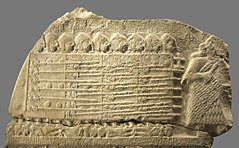Formations

This section needs additional citations for verification. (October 2017) (Learn how and when to remove this template message) |
Beginning with the development the first regular military forces, close-combat regular infantry fought less as unorganised groups of individuals and more in coordinated units, maintaining a defined tactical formation during combat, for increased battlefield effectiveness; such infantry formations and the arms they used developed together, starting with the spear and the shield.
A spear has decent attack abilities with the additional advantage keeping opponents at distance; this advantage can be increased by using longer spears, but this could allow the opponent to side-step the point of the spear and close for hand-to-hand combat where the longer spear is near useless. This can be avoided when each spearman stays side by side with the others in close formation, each covering the ones next to him, presenting a solid wall of spears to the enemy that they cannot get around.
Similarly, a shield has decent defence abilities, but is literally hit-or-miss; an attack from an unexpected angle can bypass it completely. Larger shields can cover more, but are also heavier and less manoeuvrable, making unexpected attacks even more of a problem. This can be avoided by having shield-armed soldiers stand close together, side-by-side, each protecting both themselves and their immediate comrades, presenting a solid shield wall to the enemy.
The opponents for these first formations, the close-combat infantry of more tribal societies, or any military without regular infantry (so called "barbarians") used arms that focused on the individual – weapons using personal strength and force, such as larger swinging swords, axes, and clubs. These take more room and individual freedom to swing and wield, necessitating a more loose organisation. While this may allow for a fierce running attack (an initial shock advantage) the tighter formation of the heavy spear and shield infantry gave them a local manpower advantage where several might be able to fight each opponent.
Thus tight formations heightened advantages of heavy arms, and gave greater local numbers in melee. To also increase their staying power, multiple rows of heavy infantrymen were added. This also increased their shock combat effect; individual opponents saw themselves literally lined-up against several heavy infantryman each, with seemingly no chance of defeating all of them. Heavy infantry developed into huge solid block formations, up to a hundred meters wide and a dozen rows deep.
Maintaining the advantages of heavy infantry meant maintaining formation; this became even more important when two forces with heavy infantry met in battle; the solidity of the formation became the deciding factor. Intense discipline and training became paramount. Empires formed around their military.
Comments
Post a Comment